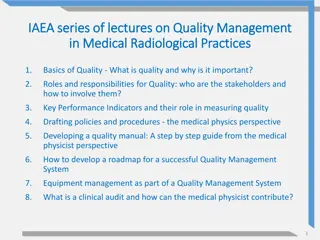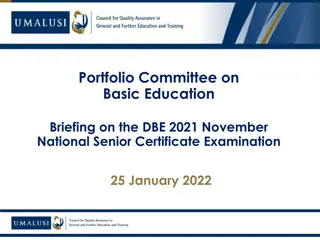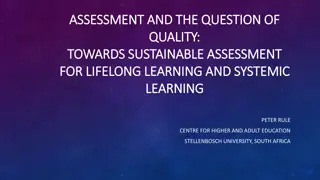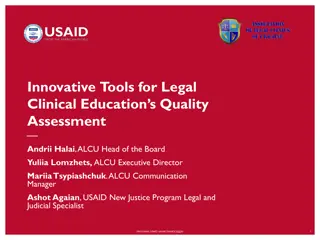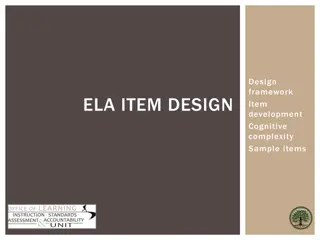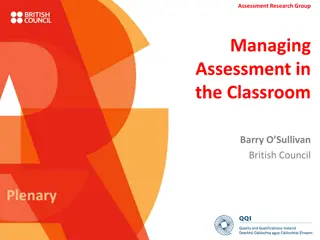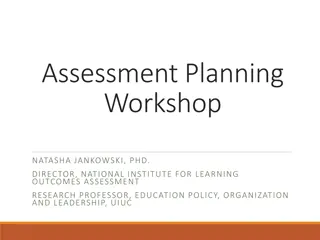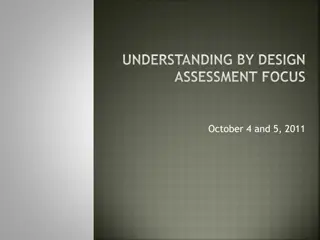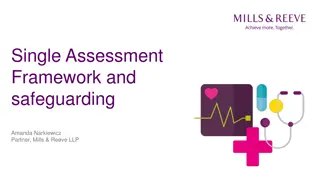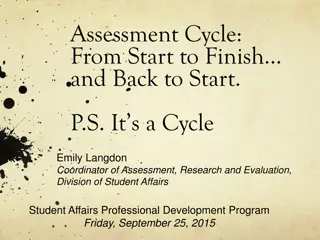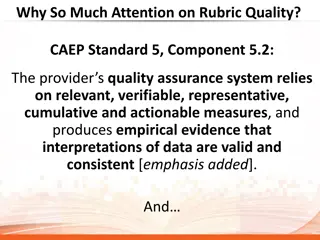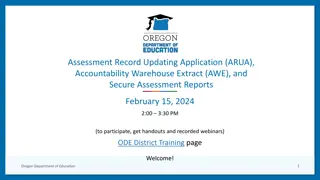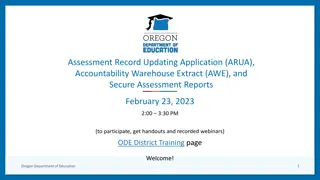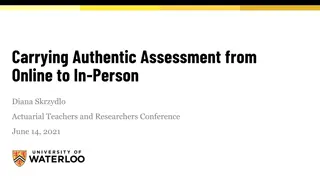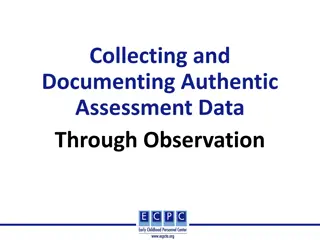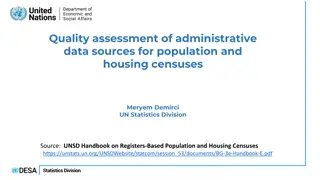Improving Quality Assessment Practices in Education: A Case Study
Assessment quality in education is crucial, especially with external and internal examinations playing distinct roles. While Botswana Examination Council (BEC) oversees credible external exams, internal assessments often lack quality, affecting students' preparedness. This study aims to compare BEC test items with internal exam items, assess the use of guiding documents, and identify reasons behind low-order thinking skills prevalence in item preparation.
Download Presentation

Please find below an Image/Link to download the presentation.
The content on the website is provided AS IS for your information and personal use only. It may not be sold, licensed, or shared on other websites without obtaining consent from the author.If you encounter any issues during the download, it is possible that the publisher has removed the file from their server.
You are allowed to download the files provided on this website for personal or commercial use, subject to the condition that they are used lawfully. All files are the property of their respective owners.
The content on the website is provided AS IS for your information and personal use only. It may not be sold, licensed, or shared on other websites without obtaining consent from the author.
E N D
Presentation Transcript
THEME QUALITY ASSESSMENT IN THE ERA OF EDUCATIONAL REFORMS Sub-theme: Using examinations feedback to support engaging learning environments. THE 13TH SAAEA CONFERENCE 19-22 May 2019 Gaborone
Presentation outline Topic Introduction Aims Background of the study Theoretical framework Action research Literature review Methodology Findings and analysis Discussion Conclusion recommendation
TOPIC A DIRECT CORRELATION BETWEEN ASSESMENT LITERACY, ITEM PLANNING AND GRADES: A CASE STUDY OF MORUAKGOMO JUNIOR SECONDARY SCHOOL.
Introduction Assessment play a vital role in the education sector as a whole. Assessment in mainstream schools is conducted by an independent sole organization called Botswana Examination Council (BEC). BEC is a body corporate mandate by an Act of parliament to conduct school examinations and any other examinations for the Ministry of Basic Education (MoBE). These are external examinations that come at the end of a three year Junior Certificate period. Such examinations are of credible quality. They are administered following a comprehensive plan and a stipulated time frame. The scope of the examination has been predetermined by an assessment syllabus.
Continuation However, internal examinations run by individual schools, regions and sub-regions have been seen to be of a total opposing low quality compared to the final examinations. In each individual school, it is the sole responsibilities of the school to have an assessment document in the academic policy that state the nature of internal examinations. On repeated occasions, it has been a norm that we as teachers administer items of a very low quality without being guided by any document. This is a problem because it leads to low quality items that have low frequency in high order thinking skills. Such items in most cases do not follow the Bloom s taxonomy concepts. This then do not prepare pupils well for the real examination. This then makes our students to exit our schools with a very low critical, analytics, evaluative and assessment skills. For this terrible practice to end, we will need a collective effort as educational practitioners to desist from setting items of low quality.
Aims of the study In arguing for standardized items as an appropriate approach to classroom and school assessment, I will explore the following. Compare the quality of BEC test items with internal examination items. Evaluate the use of guiding documents when preparing examination items. Find the causes why there is a use of high frequency of low order thinking skills in preparing items.
Background of the study Moruakgomo JSS Kweneng region 15 streamed school Social Studies- 4 teachers
Theoretical framework I did explore the use of a mixed research approach. This was relevant in the broader sense that I did collect quantitative data and used qualitative approach when deducing and or interpreting data. A mixed method research paradigms is the use of both qualitative and quantitative paradigms. This paradigm is associated with Kuhn, T, (1962, 1970) who defined it as the underlying assumption and intellectual structure upon which research and development in a field of inquiry are based. Patton, M, 2002. Such paradigm is associated with the collection of qualitative data that leads to multiple interpretations (Cohen et al, 2011, Creswell, 2003, 2004). Last but not least, in a mixed method, both qualitative and quantitative methods are used. Then I will approach the study either way.
Research type- Action research Kurt Lewin coined the term Action research in 1944 in his 1946 paper Action research and minority problems . Action research is a comparative research on the condition and effect of various forms of social action and research leading to social action that uses a spiral of steps, each of which is composed of a circle of planning, action and fact finding about the result of the action . It is cyclic Taken in the field of education This is a research in action. It is doing and practice Attempt to solve a problem with practice Applied in many ways- classroom, house, school Main practitioners-teachers, deputy, school head results are direct solutions and it is immediate Excellent for a 21st century teacher
Process of an action research Process- select a focus problem, clarify theories, set research questions, collect data, analyse, report, take informed decisions, take another cycle if no change (problem, monitor, implement evaluate start again)
Literature review In his paper; paper titled the importance of classroom assessment and evaluation system, Jabbarifar,T, (2009) states the following as an effective evaluation assessment procedure. To be useful and effective, evaluation and assessment requires planning. Preparation for evaluation should be an integral part of planning each lesson or unit as well as general planning at the beginning of the school year or course.
Continuation According to Mellati, M, and Khadeni, M, (2018) they state that, despite an emphasis being placed on classroom assessment over a number of years, evidence suggests insufficiencies in classroom assessment literacy among teachers. Too often, test data is used only for accountability, rather than to diagnose the needs of individual students and improve their education. As the report predicted, teachers and school administrators in the current No Child Left behind (NCLB) era are expected to have a sophisticated understanding of test results, to use them to make data-based decision about classroom instruction, and to communicate them to others.
Methodology Analysis of internal and external examination Administering a questionnaire to teachers 100% sample (All form threes) The researcher then took all the internal and external examinations administered to the form threes who completed their junior certificate in 2018. I observed their structure, scope, time allocated, total marks and how well the principles of Blooms taxonomy (1960 s) were exploited. Results were analysed using continuous writing, tables and charts.
Findings of external examination NUMBER OF QUESTIONS 1 2 3 4 5 6 7 TOTAL MARKS Research items Know Comprehend Apply Analyze Synthesize Evaluate END OF FEBRUARY 40 END OF TERM 1 80 END OF MAY 40 MID YEAR EXAM 80 END OF AUGUST 40 END OF SEPTEMBER 40 JCE FINAL EXAM 80
Analysis of internal examination FEBRUARY APRIL MAY JUNE JULY. MID SEPTEMBE R FINAL JC EXAM TOTAL 192 192 190 190 189 190 190 A 20 0 8 12 0 2 1 B 35 2 12 22 1 15 8 C 40 4 28 38 20 18 31 D 58 35 60 58 49 50 47 ABC (QUALITY PASS) 49.4 3.1 25.3 38 11 18.4 21 ABCD (QUANTIT Y PASS) 80 21.4 56.8 66 37 44.7 40
Internal & external 2018 QUALITY 49.4 % QUANTITY 80 % Internal exams FEBRUARY MAY JUNE SEPTEMBE R 25.3 % 38 % 18.4 % 57 % 66 % 44.7 % External exams END OF TERM 1 3.1 % 21.4 % MID YEAR EXAMINAT ION 11.0 % 36.8 % FINAL JC EXAMINAT ION 21.0 % 40.0 %
Analysis QUALITY PASS EXTERNAL EXAMS 25 20 15 QUALITY PASS EXTERNAL EXAMS 10 5 0 END OF TERM 1 MID YEAR FINAL JC EXAM
Discussion Internal examinations set in the school by different teachers are passed while external examinations set by an independent council for schools are failed There is inadequate time for doing the above Most teachers have hinted a lack of item writing skills as a factor that contributes to items of low quality Teachers also mentioned a lack of assessment planning. Shred internal examinations Just plan assessment with other educational activities
Conclusion Study to benefit schools and administrators. Internal examination to follow documents like assessment syllabus, academic policy, etc. Bloom s taxonomy principles a must. Few items leads to a shallow paper. Regions to provide an assessment schemes, quiz and standardized exercises and tests with help of BEC. Resource teachers pertaining to assessment literacy. NB: There is a positive direct correlation between assessment literacy, item planning and grades, which is; the higher the above practice the higher acquisition of skills, knowledge and attitudes when pupils exit school. And the lower the above practice the opposite
Recommendations I the researcher do recommend the following as best practices that can change not only the perceptions of educators but also their assessment practices; There has to be a frequent in-service training pertaining to assessment for the teachers through staff development programmers at school levels. Academic policies in schools should reinforce guideline that pertains to assessment activities. Topic exercises, quiz and examinations should be always guided by assessment objectives found in the assessment syllabus. Major assessment like topic tests, quiz and end of month examinations should be prepared at the regions the same time a scheme of work is done at regions. This will allow for a quality examination. This will also ensure examinations are well shred. Time allocations of examinations should be guided by the assessment syllabus of every subject and always follow such.
Recommendation cont Administration of internal examinations should follow BEC standards (Assessment principles of Bloom's taxonomy). Teacher s mind-set should change from looking at assessment as a tool for monitoring pupil s achievement, but also as a tool for giving feedback about the teaching methodologies. The school should partake in practice examinations offered by BEC. (especially low performing schools in rural areas). Reports from BEC about student s performance at the end of the year should constitute much of the subject discussions at school by individual subjects teachers. Assessment syllabus should be provided to students to familiarize themselves with, well in time before examinations. Curriculum designers and Botswana Examination Council together with Regions of Education should device a way of monitoring quality of internal examination and adherence by educators to such. & this should be done. Done and done. And done regularly.
Thinking ahead As educators, we should remove barriers to educational assessment transformation by following the robust assessment principles with assessment awareness for all (teachers, learners and relevant stakeholders), this should be the talk of the day for us to achieve quality assessment in an era of educational reforms. The vocabulary should shift from high performance and high transitions within schools, to social hope for both learners and teachers, accounted for by action research. We should facilitate faith, hope, love and charity within our educators' mind-set. This hope if advocated for, we will be sharing love in the development of an individual, a child, a hope to humanity, thereby achieving the international goal of educational for all. A human right.
Acknowledgements God for giving me the strength & courage. SAAEA & BEC for affording us this exceptional podium for sharing practices. Director for Kweneng region B. Rauwe for always saying Mr Kamankala, research with statistics, statistics ensures relevance MOBE for the sponsorship. Mentorship Mr Kgasudi & Dr Motshabi
THANK YOU NAME: MOTSERGANYI WAGO SURNAME: KAMANKALA wapapa@live.com +267 71353994 +267 73348663


